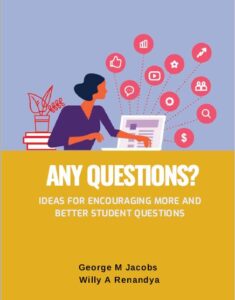Any Questions? Ideas for Encouraging More and Better Student Questions
George M Jacobs & Willy A Renandya
Abstract
One of the key characteristics of student-centered learning is the active involvement of students in the learning process, where they co-construct knowledge with the guidance of the teachers and their peers. The co-construction of knowledge can be greatly facilitated when students respond to teachers’ questions and when they themselves generate well-thought out questions. The purpose of this article is to discuss the role of student-generated questions in a student-centred learning environment and to offer practical strategies for language teachers to guide students in asking more and better student questions in the classroom, i.e., the kind of questions that promote deeper engagement and learning.
Introduction
Most of us teachers and our schools, universities, and other education institutions want to be student-centered. But what is student-centered? And, how can the questions we and our students ask create a student-centered environment?
Student-centered learning (Jacobs, Renandya, & Power, 2016), also known as learner-centered, has many characteristics, including a focus on student needs and interests, a diversity of methods and materials, a role for students in assessment, a greater role for teachers in facilitating learning than in dispensing knowledge, an emphasis on creative and critical thinking, a laboratory for students to learn skills to prepare themselves for lifelong learning, and an environment of cooperation.
What about the role of questions in student-centered learning? All the above characteristics of student-centered learning thrive on questions, especially the development by students and teachers of their question-asking abilities. The purpose of this article lies in presenting you, our fellow teachers, with ideas we have found helpful for encouraging our students to ask more and better questions to us, their classmates, and themselves. The article begins with some background on student-centered learning.
Student-Centered Learning
What is the main way that people learn? Is learning mostly from external sources, with teachers and others deciding what we should learn and poring the information into students’ heads via lecturing and other means? Or, is learning mostly an internal process, with people deciding what to learn and each developing their version of knowledge?
Teacher-centered learning focuses on the external, with teachers and their superiors in the education hierarchy deciding what and how students learn. Nowadays, we hear more about student-centered learning, with more focus on the internal, as students have more power over the what and how of their own learning. To use IT jargon, which – teacher-centered or student-centered – is about teachers downloading knowledge to students? It is teacher-centered.
Which way of learning – teacher-centered or student-centered – is more about students deciding for themselves what they want to download, and then taking that downloaded information and changing it to fit their own needs? It is student-centered.
Of course, teacher-centered and student-centered fall along a continua; they are not either/or. Even in student-centered learning, a role remains for teachers to talk, to evaluate, to demonstrate, to lead, just as we do in a teacher-centered class. However, it is a smaller part of what we do.
The importance of student-centered learning has increased today in education, due to the increased prominence of lifelong learning, the idea that even after finishing our formal education, we will continue to learn for the rest of our lives. Why is lifelong learning necessary?
First, information continually changes, and we have to be continually learning in order to keep up with the times. Second, learning makes life exciting. According to an African proverb, “Those who have stopped learning are considered the living dead.” Third, learning can be a social activity, providing opportunities to interact and enjoy with others throughout our lives.


